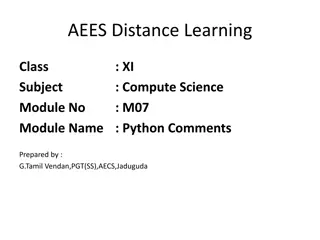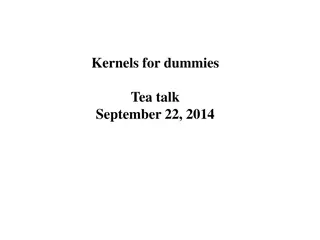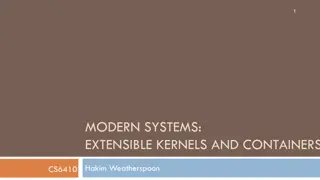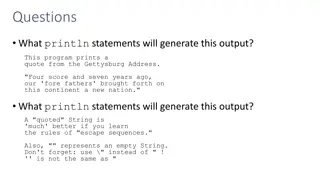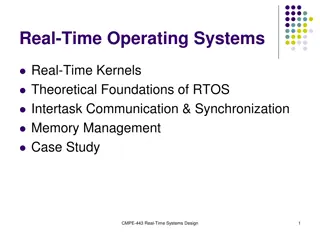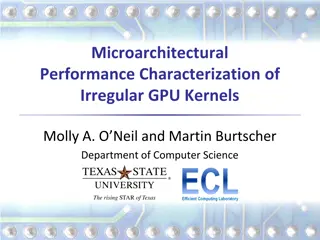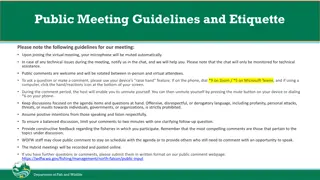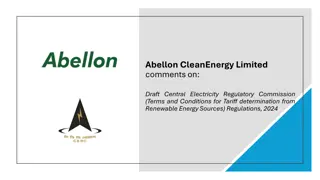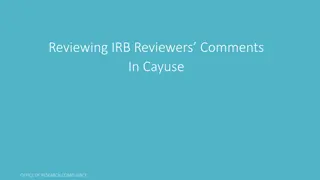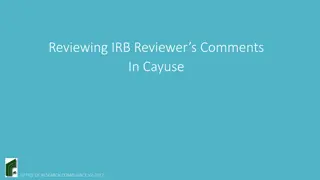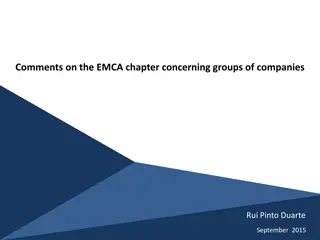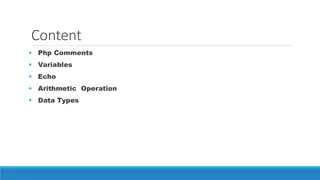
Understanding SPICE Kernels: Comments and Metadata
Learn about Navigation and Ancillary Information Facility (N.IF) comments in SPICE Kernels, also known as meta-data. Explore the importance of comments, where they are stored, how to add comments to kernels, and methods for viewing comments in binary and text kernels.
Download Presentation

Please find below an Image/Link to download the presentation.
The content on the website is provided AS IS for your information and personal use only. It may not be sold, licensed, or shared on other websites without obtaining consent from the author. If you encounter any issues during the download, it is possible that the publisher has removed the file from their server.
You are allowed to download the files provided on this website for personal or commercial use, subject to the condition that they are used lawfully. All files are the property of their respective owners.
The content on the website is provided AS IS for your information and personal use only. It may not be sold, licensed, or shared on other websites without obtaining consent from the author.
E N D
Presentation Transcript
N IF Navigation and Ancillary Information Facility Comments In SPICE Kernels Also known as meta-data April 2023 (Class version)
N IF What are Comments? Navigation and Ancillary Information Facility Comments, also called meta-data, are information that describe the context of kernel data, i.e. data about data Comments are provided inside kernels as plain text (prose) Examples of uses for comments: Data descriptions This file contains representations of the trajectories for bodies X, Y and Z over the interval from launch to landing Data accuracy comments Data pedigree How and by whom the kernel was created The program(s) and/or steps used in creation Contact information for user s questions email address phone numbers Data sources used as inputs when creating the kernel Intended kernel usage Names of companion files 2 Comments in SPICE Kernels
N IF Where are Comments Stored? Navigation and Ancillary Information Facility Binary kernels contain a reserved comment area to hold comments Text kernels have comments interleaved with the data Comments may be placed at the beginning of the text kernel, before any data, and Comments may be inserted between blocks of data using \begintext and \begindata as start and end markers: \begintext Some comments \begindata Some data 3 Comments in SPICE Kernels
N IF Adding Comments to Kernels Navigation and Ancillary Information Facility Binary Kernels Use the commnt utility program, available in the Toolkit Include comment information at the time of kernel creation using SPICE APIs (subroutines) Text Kernels Use a text editor Begin comment sections with a \begintext marker, placed alone on a line (The marker is not needed for comments occurring before any data) End comment sections with a \begindata marker, placed alone on a line (The marker is not needed if there are no data following the comments) Restrictions For both binary and text kernels Comment line length limit is 255 characters. However, NAIF recommends using no more than 80 characters per line as this makes your comments far more readable! Use only printing characters (ASCII 32 - 126) Manipulating binary kernel comments requires the kernel be in the native binary format for the machine being used For text kernels Refer to Kernel Required Reading (kernel.req) for details 4 Comments in SPICE Kernels
N IF Viewing Comments in Kernels Navigation and Ancillary Information Facility Binary kernels: Use either the commnt or spacit utility program Both are available in all Toolkits Text kernels: Use any available text file utility, such as: more, cat, vi, emacs Notepad, TextEdit, BBEdit, Word, etc. 5 Comments in SPICE Kernels
N IF Viewing Comments in Binary Kernels Navigation and Ancillary Information Facility This example shows reading the comments in an SPK file using the commnt utility program Terminal Window Prompt> commnt -r de421.bsp | more ... DE 421 JPL Planetary Ephemeris SPK ================================== Original file name: de421.bsp Creation date: Feb. 13, 2008 File created by: Dr. William Folkner (SSD/JPL) Comments added by: Nat Bachman (NAIF/JPL) This SPK file was released on February 13, 2008 by the Solar System Dynamics Group of JPL's Guidance, Navigation, and Control section. The DE 421 planetary ephemeris is described in JPL IOM 343R-08-002, dated Feb. 13, 2008. The introduction of that memo states, in part, that this ephemeris "represents an overall update for all --More-- 6 Comments in SPICE Kernels
N IF Viewing Comments in Text Kernels Navigation and Ancillary Information Facility This example show use of the unix more processor to show some of the comments at the beginning of a text kernel. Terminal Window prompt>more naif0008.tls KPL/LSK LEAPSECONDS KERNEL FILE =============================================================== Modifications: -------------- 2005, Aug. 3 NJB Modified file to account for the leapsecond that will occur on December 31, 2005. 1998, Jun 17 WLT Modified file to account for the leapsecond that will occur on December 31, 1998. 1997, Feb 22 WLT Modified file to account for the leapsecond that will occur on June 30, 1997. etc. --More--(19%) -More--(19%) 7 Comments in SPICE Kernels



